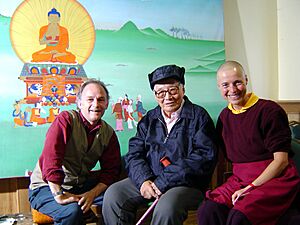Sherab Palden Beru facts for kids
Sherab Palden Beru (1911 – 29 November 2012) was a very important Tibetan artist. He was known for painting special religious scrolls called thangkas. He helped keep this ancient art alive by teaching many students from Western countries for over 40 years.
Contents
Sherab Beru's Early Life and Art
Sherab Beru was born in 1911 into a family of nomads. His family had lived in the eastern part of Tibet, called Kham, since the 1400s. When he was nine years old, he joined the Namgyal Ling monastery.
His talent for drawing was quickly noticed. At 13, he began his official art training. He learned from the monastery's main lama, who was also an artist. Nine years later, he finished his very first thangka painting.
Becoming a Master Artist
While at Namgyal Ling, Sherab Beru became very skilled. He not only mastered thangka painting but also learned other important monastery traditions. These included ritual music and special Lama dances.
In 1956, after living at the monastery for over 30 years, Beru moved to Lhasa. He stayed there for three years. However, he had to escape to India when Chinese forces took over Tibet.
Life in Exile and Moving to Scotland
Once in India, Sherab Beru started painting thangkas again. For a while, he lived in Dalhousie. There, he was asked to create many drawings of mandalas for a book.
Later, the 16th Karmapa, a very important spiritual leader, asked him to go to Scotland. In Scotland, Chogyam Trungpa and Akong Tulku Rinpoche had started the first Tibetan Buddhist center in the West. This center was called Kagyu Samye Ling, located in Eskdalemuir.
Beru had some doubts about leaving the Tibetan community in India so soon. He had just arrived there as a refugee. But he agreed to his Guru's (teacher's) wishes and traveled to Scotland.
Creating Art and Teaching in the West
For the next 35 years, Sherab Beru dedicated himself to painting amazing thangkas. He used the Karma Gadri style, which is a traditional way of painting. He also taught many students from Western countries how to paint thangkas.
You can see his beautiful artwork in centers all over Europe, Asia, and North America.
Major Artworks at Samye Ling
His most important works are at Samye Ling in Scotland. He designed the inside of the temple there. He also created several series of stunning thangkas. These paintings show important figures like the Kagyu Lineage holders, Sakyamuni Buddha, and Indian mahasiddhas. They also show the Four Directional Guardians.
Two of his most famous paintings are the Kagyu Lineage Refuge Tree and the Guru Yoga of the 8th Karmapa, Mikyo Dorje. Many artists have copied these works. He also painted the thangka of Vajradhara in a shrine room in Boulder, Colorado.
The paintings in the Samye Ling temple are known for being very large but also having incredible detail. Just like in Tibet, many of these paintings took one to three years to finish. Sherab Beru, along with Akong Rinpoche and his students, also helped save and fix old thangkas from Tibet. Many of these were damaged when China took over Tibet. Later, Beru's nephew, Gyamtso Tashi, joined him at Samye Ling. Gyamtso Tashi was a monk and sculptor who walked across Tibet for three years to reach India.
Later Life and Legacy
Even when he was in his 90s, Sherab Beru no longer painted directly. However, he remained a top expert on Tibetan art. Other thangka artists often asked him for advice.
He passed away on 29 November 2012, at Samye Ling. He was about 100 years old. After his death, his body was left undisturbed for three days. This is a traditional practice called 'Tukdam' meditation.


